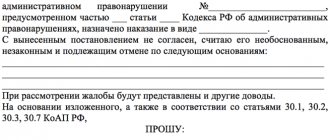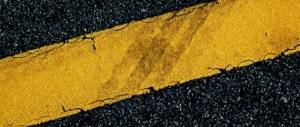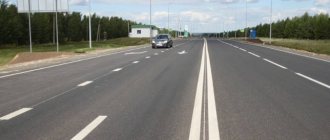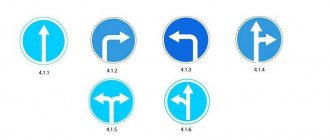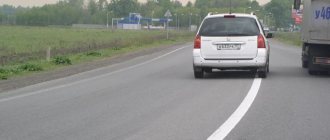Types of lane signs
“Driving in lanes” signs are a whole set of indicators indicating in which direction the driver can go. They are similar to each other: each has a white arrow on a blue background.
The traffic rules give a brief definition of these signs, but more precise information on their use and meaning is contained in GOST 52289-2004:
| Number | Meaning |
| 5.15.1 | They determine the direction at intersections and roundabouts, where high traffic intensity requires it. They indicate from which lane you are allowed to turn right or left, turn around, or go straight. They regulate only traffic flows in one direction. |
| 5.15.2 | |
| 5.15.7 | Shows the direction of travel if the road has an unequal number of opposite lanes or there are more than 4 of them. A sign with two arrows is often placed in areas where it is not always intuitive which direction it is allowed to go. |
Rules for moving vehicles
In general, the driver is prohibited from moving in the oncoming lane, as well as turning around and turning through double and single continuous markings. On a 3-lane road, the center lane is used for driving in both directions, overtaking, turning left and making U-turns. These maneuvers cannot be performed from the outer lanes.
How to move correctly within the boundaries of populated areas:
- You are allowed to drive in any lane in your direction. In heavy traffic, change lanes only to turn, make a U-turn, or go around an obstacle in order to find a parking or stop space (not to overtake).
- You can occupy tram tracks in your own direction, but only in heavy traffic (when other rows are filled with cars), for U-turns, turns and detours. In any case, you must not obstruct the tram. Signs 5.15.1/2 posted in front of intersections do not allow exit on the path.
- Do not cross solid lines between rows, change lanes only in areas with intermittent markings.
- Avoid driving directly from the turning lane and vice versa.
Special requirements apply for driving on country roads:
- You should drive as close to the right side of the road as possible, maintaining the distance between the lanes;
- Do not occupy the left lane when the right one is free.
What signs should you use to navigate the lane?
Let's look at each sign and markings separately and see how to navigate them on the strip.
Sign 5.15.1 “Traffic directions along lanes.” You can only travel in the indicated directions. If you turn right from the middle lane, the driver will be fined 500 rubles for violating the instructions of the “Go straight ahead” sign. If you turn left or turn around, you will be fined up to 1,500 rubles.
Signs 5.15.2 “Lane directions”. These signs have the same function as the previous one, but they are located separately above each stripe. Such signs are also placed if you need to cancel the effect of the previous sign.
Signs 5.15.7 “Direction of traffic along lanes.” This sign indicates that there is oncoming traffic on the left and crossing the solid line is prohibited. The sign shows which vehicles are prohibited from driving in the left lane.
Sign 5.15.8 “Number of lanes”. This sign is placed if the speed limits for the lanes are different. For example, so that the driver can safely reduce speed and turn off the road.
Marking “Direction of traffic along lanes”. Such markings are often applied before an intersection. It indicates the permitted directions of movement along the lanes. If the requirements of the markings and signs do not coincide, the driver is guided by the signs.
Current fine amounts
The following situations are in one way or another connected with a violation of the row and therefore a fine is always imposed for actions in this way. Current penalties today:
| Action, maneuver | Article of the Administrative Code | Collection amount, rub. |
| Violation of the rules for driving in lanes contrary to signs or markings | 12.16 p.m. 1 | 500 (or warning) |
| Rotate or pivot through continuous markings | 12.16 p.2 | 1000–1500 |
| Driving on a 1-lane road in the opposite direction | 12.16 h. 3 | 5000 (or deprivation of rights for 4–6 months) |
| The same thing, committed twice or more times within a year after repayment of the penalty for the first | 12.16 hours 3.1 | Imprisonment for a year (for a cell - collection of 5 thousand rubles) |
| Entering the oncoming lane to avoid obstacles | 12.15 h. 3 | 1000–1500 |
| Driving into oncoming traffic in other cases | 12.15 h. 4 | 5000 (or withdrawal of driving license for 4–6 months) |
| The same thing done a second time | 12.15 h. 5 | Imprisonment for a year (for a cell - collection of 5,000 rubles) |
What is a dividing strip and why is it needed?
This is a part of the road that diverts traffic flows, most often in the opposite direction. It can be asphalted, with a lawn, or as a marking on the road - in the form of a solid line at the edge of the roadway.
The strip demarcates traffic flows to make traffic in opposite directions safer. The car is further away from oncoming traffic, so a head-on collision is practically excluded.
Most often, a dividing strip is two curbs and a lawn that separate oncoming flows
The strip consists of two lines, with a distance between them of the car
What kind of overtaking will happen in the area of the sign?
Part 9.2 of the Russian Traffic Regulations states that overtaking in the oncoming lane is not allowed if the opposite rows are separated from each other by continuous double or single markings, or there is a prohibitory sign. Such a dangerous maneuver will result in a fine of 5,000 rubles for violating traffic in lanes under Article 12.15 Part 4 of the Code of Administrative Offences. or withdrawal of rights for 4–6 months. A secondary offense will definitely lead to deprivation of rights for 1 year, and if it was recorded by a camera, to a penalty of 5 thousand rubles.
As a rule, on roads with multi-flow traffic, signs are combined with markings. However, the traffic police warns that if there are no lines on the road, you should only follow the sign to determine the number of rows and direction of movement. The sign does not replace the markings. What does it mean?
Sign 5.15.7 can be installed on a road with two opposite lanes where the direction of flow is not always intuitive. This sign has two arrows (one pointing down, one pointing up) separated by a continuous white line. It does not mean that there are continuous markings on the road.
Advice! Sometimes outside the city on such roads the lanes are not separated by markings at all. Accordingly, overtaking on oncoming traffic is permitted in compliance with the requirements of Section 11 of the Traffic Regulations. The imposition of a fine for violating a row according to 12.15 Part 4 of the Code of Administrative Offenses (a fine of 5 thousand rubles, deprivation of driving license for 4–6 months) is unlawful. It needs to be challenged.
Violation of traffic marking requirements
Let's consider a fine and other types of liability for violating traffic markings.
When driving a vehicle, two types of violations are possible:
- failure to comply with marking requirements when making a U-turn or turning left;
- failure to comply with marking requirements regarding driving in the oncoming lane on a one-way road.
Rotate or turn around.
If there are markings on the road prohibiting a left turn or a U-turn, then for violation of these requirements in 2021 the driver will be fined in the amount of 1,000 to 1,500 rubles. No other types of liability are provided.
One way road.
A road or carriageway along which the movement of vehicles across its entire width is carried out in one direction is a one-way road. Violation by the driver of the requirements of road signs or markings, resulting in driving in the opposite direction on a road intended for one-way traffic, will be a violation of traffic rules.
For such a violation (entering a one-way road and driving in the opposite direction), two types of liability are provided (only one of the types of liability can be applied):
- a fine of 5,000 rubles or
- deprivation of a driver's license for a period of four to six months.
What is the fine for driving under a brick in 2021?
Repeated commission of this violation (failure to comply with markings) entails liability in the form of deprivation of a driver’s license for a year. However, if a repeated violation is recorded by automatic recording cameras, the driver is only subject to a fine of 5,000 rubles.
The violations described above also apply to cases of crossing a solid line, for example, when overtaking.
Violation of marking requirements by trucks is subject to a fine of 500 rubles. But if this happens in Moscow or St. Petersburg, then the fine will be 5,000 rubles.
In what cases can you challenge a fine?
In order to cancel the punishment or mitigate it as much as possible, the offender must appeal it to the head of the State Traffic Inspectorate unit or in court within 10 days from the issuance of the decision. In the following cases, this must be done:
- If a fine for violating a sign is issued in the name of the owner, although in reality the offense was committed by the driver. In court or inspection, this is confirmed by a power of attorney to drive a car, a leasing agreement, testimony of witnesses, etc.
- If the wrong maneuver was made under extreme circumstances, for example to avoid an accident. And if the harm prevented is greater than actually caused by the driver.
- If the traffic police inspector, when registering a violation of the “Direction of traffic in lanes” sign, made gross procedural errors: for example, he did not involve two witnesses and did not make a video recording.
Attention! “Driving in lanes” signs are not prohibitive. They only show the number of rows and the direction of flow on each.
Without median strips 1.1 or 1.3 it is not prohibited to change lanes into oncoming traffic for a turn, U-turn or other maneuvers. Then the driver must follow the general rules of overtaking - section 11 of the Russian Federation Traffic Regulations.
This must be taken into account if the traffic police inspector unlawfully issues a protocol for driving into oncoming traffic and threatens with deprivation of rights. Practice shows that this happens very often, but the courts mostly side with the drivers.
What fines are provided for violating road markings?
All motorists should know that there are several types of administrative liability for such a violation. The main types of punishment are: a fine for violating the markings and “deprivation”. However, there are other sanctions - for example, evacuation to a traffic police parking lot. But this article will discuss fines in detail. So there are several types of fines:
- Warning or fine in the amount of 500 rubles.
- A fine in the amount of 1 to one and a half thousand rubles.
- A fine of 3,000 rubles (valid only in Moscow and St. Petersburg).
- A fine of 5,000 rubles. or deprivation of rights from 4 to 6 months.
- Imprisonment for up to 1 year (appointed only for repeated gross violation of traffic rules).
Fine for turning left or making a U-turn in violation of traffic regulations
Often, for one reason or another, drivers break a solid road when turning left or to make a U-turn. And here we need to distinguish several nuances:
- The car crossed the marking line, moved along the oncoming lane and only then turned left.
- The car crossed the marking line and immediately turned left.
- The car crossed the marking line and drove in the opposite direction - it turned around.
In the first case, the violation is equivalent to driving into the oncoming lane and is punishable by fines in the amount of five thousand rubles or deprivation of the right to drive a vehicle for 4 to 6 months. In the second and third cases, for such violations of marking rules, a fine will be charged in the amount of one to one and a half thousand rubles.
Deprivation of rights for driving on a median strip
The fines that can be imposed for driving along the median were discussed above. However, their size is not very large, so some unscrupulous drivers drive onto the median to avoid traffic jams. Especially for them, traffic police officers came up with a cunning scheme that included deprivation of their rights. Let's look at its details:
- There is a traffic jam on the road with cars in all lanes. A good example is Kutuzovsky Prospekt in Moscow during rush hours.
- The traffic police car is stuck in a traffic jam along with everyone else (in the left lane).
- As soon as there is a cunning person who wants to bypass the traffic jam along the dividing strip, the police turn on special signals (flashing lights and siren) and drive out onto the dividing strip.
- The patrol car catches up with the offender, who must give way to the police in accordance with paragraph 3.2 of the traffic rules. However, he cannot do this, because... There is nowhere to escape from the dividing strip.
- In such a development of events, the driver may receive punishment under Part 3 of Article 12.17 of the Code of Administrative Offenses (500 rubles or deprivation of rights for a period of 1 to 3 months).
In this case, traffic police officers artificially create a situation in which the driver violates the requirements of the rules. This is not a very common practice, but before you start being cunning and driving onto the median, I recommend remembering that the police can also be cunning.
Good luck on the roads!
